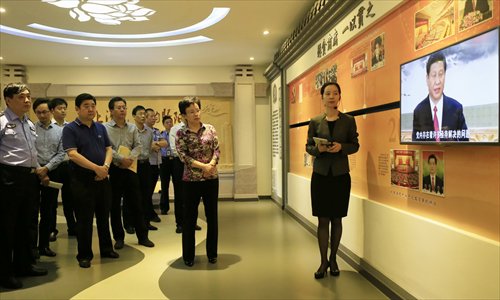HOME >> CHINA
Anti-graft exhibitions aim to deter officials from being corrupt
By Cao Siqi Source:Global Times Published: 2015-8-9 19:33:01

More than 90 newly-appointed government officials in Jiangyin, Jiangsu Province, visit an anti-corruption education center on May 13. Photo: Beijing Sanyueyu Company
The stories of hundreds of corrupt officials' lives are told on display boards or through videos in a hall in Beijing. How they were lured into the abyss of corruption, what crimes they committed and what punishments they eventually faced. All these stories are vividly told to the civil servants and officials that visit the hall by a guide.
In the middle of the exhibition hall, there is a replica of a detention facility. When the gate opens, the visitors are led into the mock facility so they can see clearly what their homes will be if they are suspected of corruption. There is a simple bathroom with glass walls on the right-hand side and board detailing the strict daily routine of prisoners on the left-hand side. In the middle of the wall is TV playing a video about how a suspect was taken into custody and underwent interrogation. Under the TV, there is a bare wooden platform which could one day be their bed.
This is an anti-graft exhibition. Similar exhibitions or education centers can be seen across China as under the sweeping anti-graft campaign the authorities have sought to educate officials about the consequences of corruption and hopefully scare them straight.
However, as more of these anti-graft exhibitions or education centers are built some worry that this too may evolve into another form of corruption.
Gaining popularity
The Beijing Sanyueyu Company, a media business established in 2003, is a leading firm in this industry. The company has been dedicated to providing services ranging from designing centers and collecting materials to construction work and training interpreters for discipline watchdogs, procurators and other government institutions. The company has had a hand in over 500 anti-graft exhibitions.
A Sanyueyu employee surnamed Li told the Global Times that the company's business has been growing every year and saw a sharp increase after the 18th National Congress of the Communist Party of China (CPC) in 2012, when the campaign began.
Government organs such as discipline watchdogs and procuratorates pay media companies like Sanyueyu to put on these exhibitions.
According to Li, more and more companies have started to build these centers in recent years and Sanyueyu expects to establish about 100 exhibitions this year.
The Global Times contacted another media company which provides similar services and a worker surnamed Yuan said that his company's business has been expanding under the ongoing anti-graft campaign.
According to Li, a 400-square-meter exhibition hall costs around 2 million yuan ($322,000) and the price ranges from 5,000 yuan to 20,000 yuan per square meter while Yuan said that the more high-tech the display methods used, the higher the price they charge.
However, both said that such exhibitions are not very profitable. "The price is comparatively low as the exhibition is about anti-graft. It is for education instead of shaping an image," said Li.
Walking on thin ice
Despite having been told that the exhibitions are only open to civil servants or officials, the Global Times reporters were given permission by Li to visit an exhibition hall in Dongcheng district in Beijing on August 4.
Over 10 officials listened to the tales of corrupt officials. They were taught about the reasons these officials fell into corruption, were presented with a wall covered with their confessions, warned of the serious consequences of corrupt practices and shown videos about money-power trading and the profit chain behind corruption.
An official surnamed Gao told the Global Times that "we should come to the exhibition very often. It could serve as a warning and also an inspiration for my future work."
According to Yuan, exhibitions held by his company sometimes feature special effects. For example, using lights and sounds they make attendees feel like they are standing on thin ice and that any unlawful practices could cause them to fall into the freezing embrace of a long prison sentence.
"The exhibitions aim to prevent corruption in the first place," said Li, adding that the company has also built exhibition halls for teenagers to help them establish mainstream moral values at an early age.
The guide at the Beijing exhibition hall told the Global Times that many officials have applied to visit and she guides four or five groups each day.
According to the Beijing Youth Daily newspaper, an education center in Haidian district that was established in April 2014 has received over 230 government institutions and nearly 7,000 officials.
New form of corruption?
The popularity and expansion of this new business has drawn criticism as some see it as a poor use of government resources.
While such exhibitions play a role in anti-graft campaign by educating officials and deterring corruption, a commentary from the Hunan-based rednet.cn argues that the high cost of building exhibitions is a waste of government resources. The industry also may generate new illegal profits and be manipulated by some people for the purpose of grabbing public resources, turning it into the source of another form of corruption.
The commentary suggested the government spend the money on more direct anti-graft measures.
China's central disciplinary watchdog uncovered 1,650 cases of officials violating anti-graft rules in January, and of those who committed violations, 1,406 have been given Party or administrative punishments.
Over the more than two years of the anti-graft campaign, thousands of officials have been investigated, from Zhou Yongkang, former member of the Standing Committee of the Political Bureau of the CPC Central Committee, to county-level officials.
Newspaper headline: Demanding discipline
Posted in: Politics